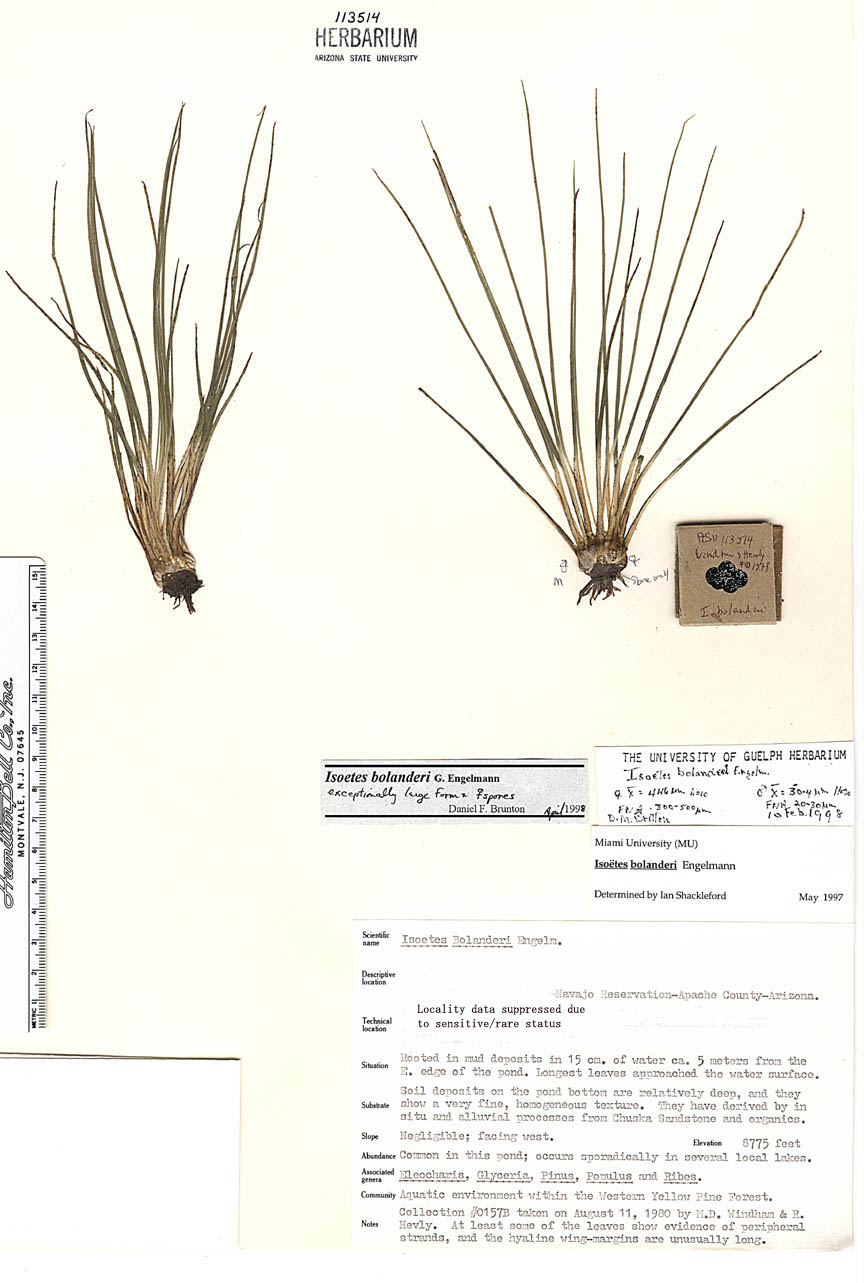
|
Isoetaceae |
|
|
Plants tufted, grasslike, heterosporous (megaspores and microspores not alike), perennial; evergreen aquatics to ephemeral terrestrials. Rootstock brown, cormlike, lobed. Roots arising along central groove separating each rootstock lobe, simple or dichotomously branched, containing eccentric vascular strand and surrounding lacuna. Leaves linear, simple, spirally or distichously arranged, dilated toward base, tapering to apex, containing 4 transversely septate longitudinal lacunae, a central collateral vascular strand, and frequently several peripheral fibrous bundles; ligule inserted above sporangium. Megasporophylls and microsporophylls usually borne in alternating cycles; hardened scales and phyllopodia occasionally surrounding leaves. Sporangia solitary, adaxial, embedded in basal cavity of leaf, velum (thin flap extending downward over sporangium) partly to completely covering adaxial surface of sporangium; megasporangium with several to hundreds of megaspores; microsporangium with thousands of microspores. Megagametophytes white, endosporic, exposed when megaspore opens along proximal ridges; archegonia 1 to several, indicated by quartets of brownish neck cells. Microgametophytes 9-celled, endosporic, antheridium releasing 4 multitailed spermatozoids. PLANT: Perennial herbs, heterosporous. ROOTS: adventitious, arising from between the stem lobes, unbranched or branched. LEAVES: usually numerous, deciduous, appearing tufted, linear, tapered to the sharply pointed tip, glabrous, hollow (with 4 longitudinal chambers) with a single midvein, the base broadened and convex (spoon-shaped), bearing 1 sporangium in a shallow pit on the adaxial (inner) side and a thin scale (ligule) adjacent and distal to the sporangium. STEMS: usually 2-lobed, stout, short, fleshy, cormlike, with reduced internodes, lobed. SPORANGIA: of 2 types, usually on the same plant, thin-walled, lacking an annulus, breaking open irregularly through decay, partially covered along the margin by a flap of tissue (velum), some with numerous megaspores, others with numerous microspores. MEGASPORANGIA: with 50-300 megaspores. MEGASPORES: relatively large, much bigger than the dust-like microspores, trilete, globose. MICROSPORANGIA: with 150,000 or more microspores. MICROSPORES: monolete, bean-shaped. GAMETOPHYTES: reduced, developing inside the spores, the archegonia and antheridia protruding from the spore wall. —1 genus, ca. 150 spp., nearly worldwide. REFERENCES: Windham, M. D. and G. Ytskievych. 2009. Vascular Plants of Arizona: Isoëtaceae. CANOTIA 5 (1): 27-29. |
|
This project was made possible in part by the Institute of Museum and Library Services [MG-70-19-0057-19].
Powered by Symbiota


